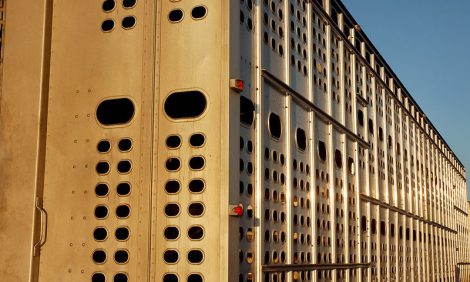



Consider Pros and Cons of Alternatives to Corn
By J.W. Schroeder, Dairy Specialist NDSU Extension Service. Producers need to consider the advantages and disadvantages of substituting less costly feed for corn in dairy cattle diets.
 |
| J.W. Schroeder, NDSU Extension dairy specialist |
With feed accounting for half or more of the cost of producing milk, many dairies are looking for alternatives for corn, which historically has been a low-cost feedstuff.
A portion of the corn in the dairy cow’s diet can be substituted with alternative feeds. But you are not going to replace all of the corn and get the same level of milk production.
Corn provides energy and starch. Several alternatives are available to replace the energy in the diet, but replacing the starch is harder. This and the fact that other ingredients often are expensive when corn is pricey lead industry experts to concur that corn should not be abandoned altogether. Rather, substitutes should be included only when they have a better nutritional value than that of the high-priced ingredient they replace.
This past year, about 20 percent of the nation’s corn crop was used to produce 4.8 billion gallons of ethanol. The percentage of corn that will be used for fuel production could increase even more because federal legislation has mandated that ethanol use reach 7.5 billion gallons by 2012.
But do these statistics doom dairy producers to a life of high corn prices? Or will other factors stabilize the price of corn, as they have in the past?
In the short term, corn prices are expected to remain in excess of $3 per bushel. In the long term, economists predict the price of corn will drop to more normal levels of around $2.50 per bushel as acreage and yield increase and other sources of carbon for ethanol production are found. Also, alternative fuels, such as hydrogen, methane, wind, solar and nuclear, may reduce the demand for ethanol.
Once all projected ethanol plants in North Dakota are on line, they will provide approximately 489 million gallons of ethanol in one year. Based on the 2006 harvest of 163.8 million bushels of corn, full plant capacity would require more than 106 percent of our current corn production. The shift in acreage to meet this demand has current markets speculating on future availability and price. While the upsurge in corn and other grain prices is an optimistic situation for growers, livestock producers who use corn, especially dairy farmers, are faced with some major out-of-pocket expenses.
One of the benefits that have come from the growth of the ethanol industry is the availability of corn distillers grain (DG), a byproduct that comes from the manufacture of ethanol.
If you’re looking to replace some of the corn grain in the diet, consider including feeds that are high in starch. (Alternative feeds contain varying levels of starch, crude protein and phosphorus.) Make sure to work with your nutritionist to formulate a balanced ration that addresses not only the expense side of the dairy, but the production side as well.
Looking for cheaper feed alternatives will require juggling nutritional and financial resources for more efficient feeding.
When corn is $4 per bushel ($143 per ton), the energy cost per unit is 9 cents. The energy cost per unit is an equivalent 9 cents when distillers grains and hominy are $140 per ton, whole cottonseed is $155 per ton and corn gluten feed is $135 per ton. At times, corn may be more expensive per ton, but the energy (total digestible nutrients) cost may be nearly equal while also providing a more desirable energy profile for the rumen. Thus, price alone should not determine what ingredients are included in the ration.
One guideline is to replace half of the soybean meal or other protein sources in the diet, such as canola or cottonseed meal, with distillers grains. Limit distillers grains to 10 percent to 20 percent of the total dry matter in the ration and monitor the milk fat test as an on-farm evaluation of excessive unsaturated oil.
Another guideline is the composition and quality of the product. Composition can vary from facility to facility and from batch to batch, so analyzing the product before it is used is imperative.
Many distillers are realizing this is a problem and are working to make improvements. Most will provide an analysis of the product before it is purchased.
Also make sure you check for the presence of aflatoxins, a mycotoxin that is not destroyed in the elevated temperatures of drying the distillers grain. Aflatoxins are illegal in milk and a human health hazard.
|
Nutrient value of alternative feeds |
|||
| Commodity | Starch | Protein | Phosphorus |
|---|---|---|---|
| (%) | (%) | (%) | |
|
Barley
|
55-60 | 12 | .39 |
|
Beet pulp, dry
|
2 | 10 | 10 |
|
Brewers grains
|
10 | 29 | .67 |
|
Canola meal
|
2 | 41 | 1.00 |
|
Corn
|
65-70 | 9 | .30 |
|
Corn gluten feed
|
12 | 24 | 1.00 |
|
Corn silage
|
25-30 | 8 | .20 |
|
Cottonseed
|
1 | 24 | .60 |
|
Distillers grains
|
5 | 30 | .83 |
|
Sorghum grain
|
65-80 | 12 | .35 |
|
Soybean hulls
|
1 | 14 | .17 |
|
Wheat
|
65-70 | 14 | .43 |
|
Wheat midds
|
15-20 | 19 | 1.02 |
Source: NRC Dairy, 7th Revised Edition, 2001 |
|||


